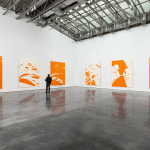In an elegant group show at Minus Space, “Neither Here nor There but Anywhere and Everywhere,” curator Matthew Deleget has selected work that looks visually simple, but each piece tells a deeper story about camouflage, subterfuge, and the act of making art. Rooted in stripped-down Minimalist aesthetics and the work of the 1960s French Supports/Surfaces artists who focused on deconstructing the materials (canvas and stretchers) rather than creating an illusion with paint, the pieces in the Minus Space exhibition use materials as image, illusion, and metaphor.
Carrie Pollack, Soft Sky, 2012, pigment ink on canvas, 34 x 24 inches. Simultaneously evoking both presence and absence, Pollack prints an image–a photograph of a clear blue sky that’s been converted to greyscale–on a loosely stretched canvas. Or is the the printed image, which makes the canvas look like unprimed linen, creating the illusion of looseness?
 Victoria Munro
Victoria Munro,
OR, THE WHALE, 2010, white porcelain, 10.5 x 10.5 x 1.5 inches. Contemplating the post-modern painters’ challenge, Munro creates delicate porcelain sculptures that look exactly like primed, unpainted canvases.

Julian Dashper, Untitled (2002), 2001-2002, cut cedar stretcher, 36 x 36 x 1.25 inches. Cutting the stretcher into a geometric shape, Dashper activates the surrounding space, causing confusion between negative and positive space, image and object.
Linda Francis, Interference, 2011, oil on aluminum, 3 panels, 3 x 9 feet 2 inches overall, each panel 3 x 3 feet. Francis told me at the opening that her piece, which looks like a photographic enlargement of small cloud puffs arranged in a grid format, is derived from a microscopic photograph of the silicon structure/coating on the heat shield of the Challenger, the
1986 space shuttle in which all seven crew members died in a horrific explosion during the launch.
Michelle Grabner, Untitled, (front) 2007, Flash and black gesso on canvas, 50 inches diameter. Grabner’s painting hangs in the middle of the gallery.

Michelle Grabner,
My Oyster, (back) 2012, 4 art works by Michelle Grabner, 1 art work by Brad Killam, child�s chair, green washcloth, steel cable, 50 x 50 x 13 inches overall. From one side, the piece is a series of small, obsessively rendered
monochromatic dots that coalesce into a geometric pattern evoking
aboriginal dot paintings of Papunya.
As the tondo slowly turns, the back reveals a series of smaller
paintings and household objects attached carefully to the stretchers. I
like the idea here, but I’d like to see a more chaotic arrangement of
junk and debris. (But I guess that tells you more about my experience
than about the
work per se, right?)
Russell Maltz,
S.P./DWG, 2002, ink on 4 papers, steel pin, 29 x 11 x 2.5 inches. A compulsive stacker, Maltz contributes a piece that looks like charred shingles hanging from a nail, but they are actually pieces of heavy paper doused in multiple layers of chalky, dried black ink. I think he would like
this picture.

Vincent Como,
4.5 Cubic Inches (Volume of the Inside of My Head), 2007, cast Sumi ink, shelf, 4.5 x 4.5 x 4.5 inches. Como, who has narrowed his quasi-conceptual practice down to what he sardonically calls the Singularity of Black and Infinite Blackness, creates a small sculptural object using dried Sumi ink. Perhaps if we distilled all the ideas that artists have ever explored, the result would be as rich and dense as Como’s cube.
Also: I’m looking forward to checking out “
Stretching Painting,” a group show at Galerie Lelong, curated by
Veronica Roberts, that explores similar Supports/Surfaces strategies. Artists include
Patrick Brennan, Sarah Cain, Hilary Harnischfeger, James Hyde,
Alex Kwartler, Jim Lee, Lauren Luloff, Donald Moffett, Gabriel
Pionkowski, and Kate Shepherd.
“
Neither Here nor There but Anywhere and Everywhere,” Minus Space, DUMBO, New York, NY. Through August 11, 2012. Artists include Vincent Como, Julian Dashper, Linda Francis, Michelle Grabner, Russell Maltz, Victoria Munro, and Carrie Pollack.
Note: All images courtesy of Minus Space.
Related posts:
Claude Viallat: Exploring Casualist abstraction in 1960s France (2011)
Erik Saxon’s rigor and play (2011)
A Loren Munk report (2010)
——-
Subscribe to Two Coats of Paint by email.
Related
 Victoria Munro, OR, THE WHALE, 2010, white porcelain, 10.5 x 10.5 x 1.5 inches. Contemplating the post-modern painters’ challenge, Munro creates delicate porcelain sculptures that look exactly like primed, unpainted canvases.
Victoria Munro, OR, THE WHALE, 2010, white porcelain, 10.5 x 10.5 x 1.5 inches. Contemplating the post-modern painters’ challenge, Munro creates delicate porcelain sculptures that look exactly like primed, unpainted canvases.




























